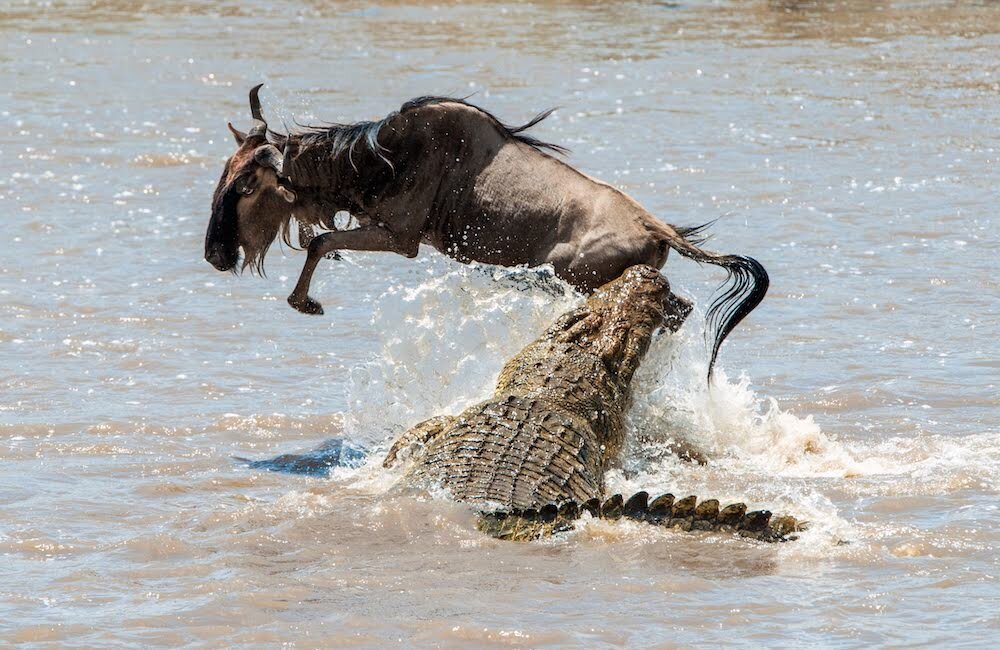When can you see the Great Migration?
What makes the Great Migration so special?
The Great Migration is one of the most incredible wildlife experiences on the planet. Unique to Tanzania (and a very short stint in Kenya’s Maasai Mara), it’s the largest overland migration in the world, with over 1.5 million wildebeests, 200,000 zebras, and a variety of other antelopes traveling over 600 miles across the country each year in search of food and water.
But, although their path is cyclical it is difficult to predict. The animals move towards the rain which means that as they journey towards the wetter areas they can get distracted by intermittent rain elsewhere. 20% of the wildebeest might smell rain and decide to change course completely, going back in the direction they came from. Eventually their path will take them back to join the rest of the group but in the meantime, there is a small possibility that you could miss them! More on how we mitigate the “wildebeest risk” below.
Experiencing the migration is one of the best reasons to come to Tanzania for a safari. But, before you plan your trip you’ll need to know the best time of year to go.
When is the best time to experience the Great Migration?
Our team gets this question all the time from our clients. We know there is a ton of information our there on the Great Migration but it can be hard to find the answers you need.
We decided to build this interactive map to help you plan your journey. From calving season with more than 8,000 babies being born in a single day, to the river crossing in the dry season, the best time to see the migration depends on what you’re most interested in experiencing.
December - February: Calving season for wildebeest and zebras so there are high chances to spot tons of new babies and to see the predators at work.
March - April: The migration’s babies are starting to grow which means the animals are on the move! They spread across Southern Serengeti’s short grasses eating up everything in site before starting their big next move.
May - July: The migration is making its way through central Serengeti, home to tons of big cats, stunning scenery, and incredible lodges and camps. There’s also the crossing of the Grumeti river which happens during this period.
August - September: The animals cross the Mara River in the North of the park – with crocodiles serving as their biggest enemy.
The Map
Tracking the Great Migration is a once in a lifetime experience. We’re working to make it a little easier with our interactive map that helps you plan the best time to visit Serengeti.
Did you know?
Wildebeest actually do not migrate
As a species, wildebeest are actually non-migratory. So, what makes Serengeti's wildebeest unique? Some theories include: (1) Some wildebeest might be in charge and communicating their decisions to the others (2) It may be the chemistry of the grass (3) It might be in their DNA
Zebras and Wildebeest have the ultimate love story
Zebras and wildebeest rely on each other as they travel across Serengeti. Some reasons include: (1) Zebras love the taller grass, while wildebeest prefer the shorter stuff. (2) Both zebras and wildebeest enjoy grazing in the wide open African savannas. By teaming up, they are much safer. (3) Zebras have incredible eyesight, while wildebeests have a strong sense of hearing. These species act as allies in warning one another of any impending danger or threats.
The Real Circle of Life is on the Migration
Calving season marks the beginning of the Migration and the lifecycle of the animals traveling it. Death is the end of the circle of life that happens during the Great Migration. Approximately 250,000 wildebeest and 30,000 zebra are killed each year by predators along the migration, as well as from natural causes such as thirst and hunger. Predators include big cats like hyenas, cheetahs, leopards, and lions, as well as hungry crocodiles.



